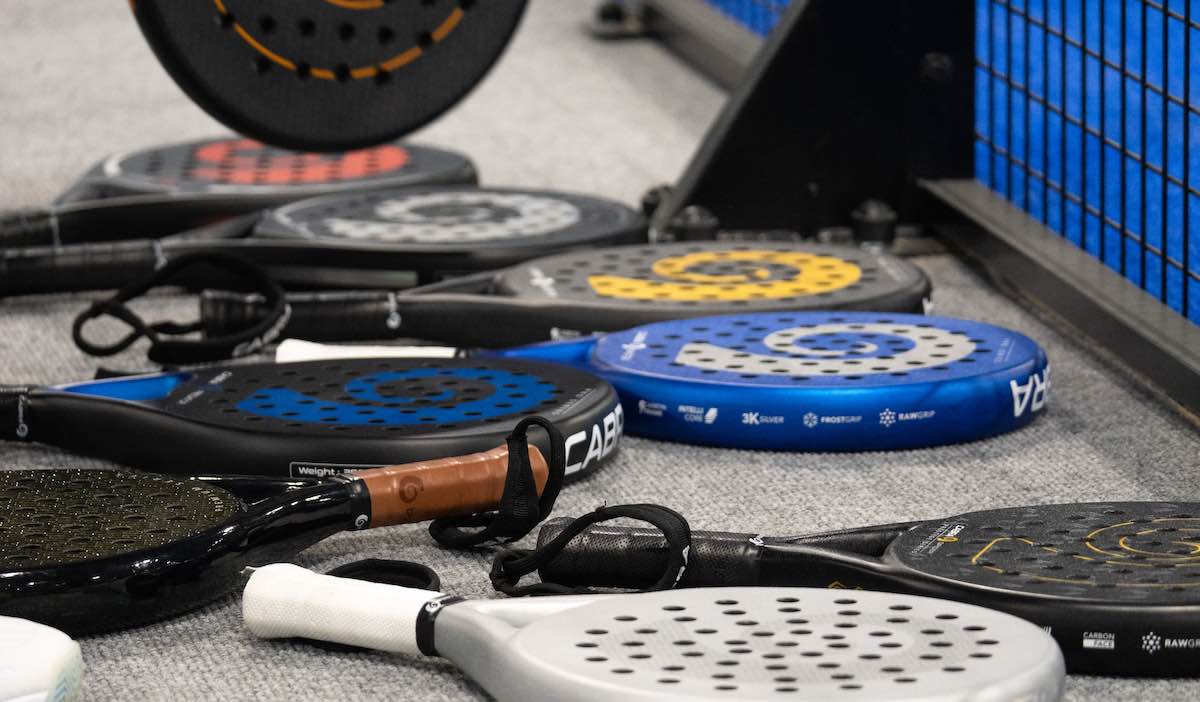Padel tennis rackets are one of the essentials for padel players. The best racket for advanced players is usually made of a carbon fiber racket face, carbon frame, and EVA rubber core.
Carbon fiber bats offer more power, resistance, and durability. It’s designed for the player to have a good grip plus a nice spin on the ball upon contact.
On the other hand, beginner padel rackets are made of fiberglass face and frame and a foam core material.
Fiberglass rackets are less resistant and durable compared to carbon fiber bats. Hence, it’s only suitable for occasional practice matches.
But, no matter what materials were used, your padel tennis racket will eventually lose its shape and show signs of wear and tear.
When the racket loses its shape, it consequently loses its ability to give a good spin and will affect how you play the game.
Once you feel that it no longer has enough elastic properties to give a powerful blow and start noticing a vibration upon contact, it’s HIGH TIME to change your racket.
If you don’t know what signs to look for to change padel racket, read on! We’ll explain all these to you in detail.
Damages that require you to change your racket immediately
In the long run, you will notice visible wear and tear on your padel rackets. This may be due to several factors, including:
- Improper storage
- Heavy usage
- Unnecessary hitting
- Lack of protection
Conversely, these lead to serious damage on the frame and racket face that can’t be fixed, as well as a soft core material.
OBVIOUS TIP OF THE DAY:
Don’t wait a year or two before changing your padel rackets. Once you notice visible wear and tear, or any signs of racket damage, change rackets right away.
Either of these racket damages impact rackets’ performance. It will lack responsiveness when it contacts the ball in play, and you’ll start feeling a vibration on your arm upon contact. It will be similar to not finding the sweet spot of your racket. The racket will give you feedback so to speak.
You may not know it, but racket damage can cause discomfort and injuries to your joints, especially your elbow.
Before all these things ruin your game and cause you to lose a match, you should toss your current racket away, no matter if it’s your favorite or good luck racket.
Overview of how often you play vs. how often you should change your padel racket
Should you replace your gear after 6 months or a year? There’s no single answer to this.
The frequency of your game would also determine how often you should change your racket to keep it in premium condition.
| Frequency of play | Frequency of padel racket change |
|---|---|
| Recreational (1-2 times/week) | At least once a year |
| Amateur (3-5 times/week) | At least twice a year (every 6 months) |
| Semi-professional | Four times a year (every 3 months) |
| Professional | Six times a year or more (minimum every other month) |
Professional players must change their racket often because they play more frequently and engage with more powerful strikes. Hence, the quality of their general gear such as padel shoes and padel rackets degrades quickly.
But, for recreational plays with less violent blows, your racket will last a long time. Yet, this still depends on the quality and make of your equipment.
NOTE:
If you’re a pro, keep at least two rackets of the same type and use them alternately. In case of a switch, you’ll feel no difference between your gear.
The different types of cracks of a padel racket
As a player, you fear the day that your racket falls short and loses its ability in playing a superb padel match. You may feel quite worried when you see a small crack in your gear.
True enough, the appearance of visible cracks is one sign that you need to get yourself a new racket.
Even the slightest form of racket damage is a big influence on your overall performance.
But there are also types of crack that are still playable. You can still use your paddle racket until your match ends or during practice games.
Cosmetic cracks
One type of damage you can see on your racket is a cosmetic crack. This does not impact your rackets’ performance. Only the appearance is affected by such a crack.
If you’re racket only has cosmetic damage, the frame, face, and core are still intact. You can still hit the ball nicely and make good returns. You shouldn’t feel too worried about it.
Chip cracks, paint cracks
Chips and scuffs on the paintwork can be considered cosmetic damage. You’ll probably notice scratches only on your racket’s surfaces, and it doesn’t cut deep on the face, frame, or core.
You can get these when accidentally bumping your racket on hard surfaces or playing low shots to scoop the ball.
Similarly, this type of damage on your racket is NOT a significant concern. Your gear is still playable, and there’s no need for you to get a new racket immediately.
Internal cracks
This type of crack is something that would greatly impact your performance on the court.
With this, you’ll notice damage between the holes on the face of your racket, and the carbon or fiberglass holding it together have splits.
In this case, your racket starts to give off less power when hitting the ball. But usually, the crack is only visible on one side.
You can still play with such damage. But you must understand that the playable side is the one without a crack.
This type of crack can be a result of hitting the ball hard or unnecessarily hitting the knees, palms, or other objects in the court.
There’s also a possibility that the foam softened due to high temperatures.
Serious cracks
A more serious type of crack in padel tennis rackets is those that are seen on the frame, where splits cut much deeper compared to the other two.
You can no longer wait out another set of the game with a serious crack. You must find a replacement racket IMMEDIATELY, especially if you’re playing in a tournament.
Hence, we suggest preparing spare gear before you play on the court or getting a new racket after.
Cracks on the frame
Damage to the frame of your racket can happen when you clash with your partner or hit the ground too low in an attempt to save the ball in play.
This can also happen when you hit the fence or glass in the court.
How to prolong the lifetime of your padel racket
Sometimes, we wish to prolong our racket’s duration because we don’t have the luxury of buying a new padel tennis racket every so often.
Aside from investing in good quality rackets and assessing the material racket is made, you should also know how to care for your gear.
Learn a few tips from us to prolong the life of your padel racket below.
Avoid high temperatures
Stashing your racket in your car boot or letting it sit in warm areas is a big no go.
A racket that’s constantly exposed to high temperatures won’t only ruin the style and design, but it will also cause the racket to lose its elasticity and other properties.
The foam will lose its shape, and it will affect the way it contacts and return the ball in play across the court.
Avoid slamming your racket in the ground
Unnecessarily slamming your racket into the ground or into different objects out of fun, frustration, or mannerism will shorten the life of the racket.
This will result in scuffs, cuts, and scratches that will cause the racket to eventually break.
Use superglue for small cracks
Superglue can help you mend minor damages on your racket frame and face. Once you notice scuffs on the materials, fix them RIGHT AWAY to prevent them from cutting deeper and getting bigger.
Keep your racket dry
You must wipe your racket to protect it from bacteria build-up and prolong its life. Keeping it damp will ruin the inner core materials of the racket.
Hence it will alter the responsiveness of the racket upon contact, making poor returns.
Protect with Protective Strips
You can also protect the frame of your racket by applying protective strips around them. This can PREVENT scuffs and scratches that will eventually lead your racket to break.
Recommended reading:
How to change your padel racket overgrip (tutorial)
Conclusion
Knowing when to replace padel racket is essential not only for a professional player but hobbyists as well.
This will protect you from possible injuries and help ace a well-played game.
As a player, you’re the one responsible for caring for your gear and knowing when to start scouting for a replacement racket.
Playing with a racket in good condition will greatly influence how you play in a match. Don’t let a lousy racket ruin your game style.
Frequently Asked Questions – When to replace your padel racket
Find a replacement once you feel discomfort and notice visible signs of wear and tear. You should also do so if you need an upgrade from beginner to pro. The racket can highly influence your returns. So, when your level rises, replace your old gear.
Ideally, you should own at least two rackets. When the other one breaks, you have a spare readily available. Use these alternately, so you feel no difference when switching gears.
Padel bags are an excellent investment to ensure proper storage. You should also keep your racket dry. Apply and change your racket’s protective strips as well.

Lucas Sánchez is the founder of SimplePadel. Born and raised in Spain, Lucas has been living in the US and UK for the last 20 years and currently calls Miami his home. While he’s never played professionally, the dream is still alive.
Lucas loves nothing more than playing (and talking) about padel, and he considers himself lucky to have a wife and family that share his love for the game.

9 replies on “When to replace your Padel Racket”
Thanks
You are welcome Ben!
[…] Integrated Protector technology made with a pre-molded carbon bumper to protect the racquet from chips and scratches […]
[…] If you are a fan of the color green, you will love the accents on this racket. This adds to the sense of sustainability since the colors green and brown often represent the […]
[…] Bullpadel Indiga Control 22 racket has a round shape frame made of carbon composition to ensure the longevity of use, resistance, and […]
[…] you’re just starting out in padel or looking to upgrade your existing racket, the Grandcow Flash Carbon Fiber Power Lite Pop Tennis paddle racket is an excellent choice for […]
[…] Thanks to its graphite construction, you’ll be able to use the Dunlop Rapid Power 3.0 racket for a long time because of its superior durability. […]
[…] allows players to get a good feel of the racket and is combined with carbon materials ensuring the padel racket will last longer than […]
[…] High memory and density core highlighting the Power Embossed Technology to increase the rigidity of the structure and the durability of the racket […]